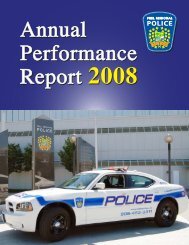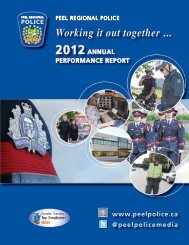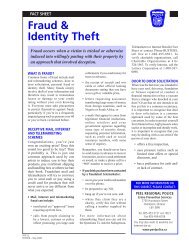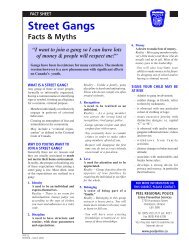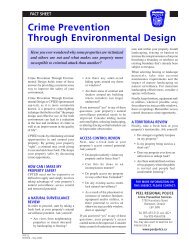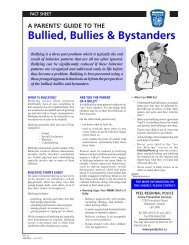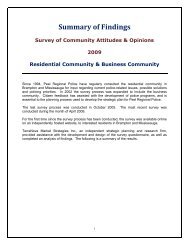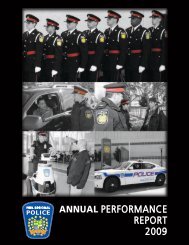2011 Equal Opportunity Plan - Cover.indd - Peel Regional Police
2011 Equal Opportunity Plan - Cover.indd - Peel Regional Police
2011 Equal Opportunity Plan - Cover.indd - Peel Regional Police
You also want an ePaper? Increase the reach of your titles
YUMPU automatically turns print PDFs into web optimized ePapers that Google loves.
PEEL REGIONAL POLICECORPORATE RECRUITING AND DEVELOPMENT“POLICING IT’S MORE THAN YOU THINK...”Equitable Access To <strong>Opportunity</strong><strong>Equal</strong> <strong>Opportunity</strong> <strong>Plan</strong> Results <strong>2011</strong>
EQUAL OPPORTUNITY PLAN RESULTS <strong>2011</strong>TABLE OF CONTENTS123456EQUAL OPPORTUNITY PLAN .................................................................... 1Community Representation Data ...........................................................................................2Language Profile – Community & <strong>Police</strong> Service .....................................................................2STATISTICS – UNIFORM REPORTING ......................................................... 3Applicant Data – Uniform (Recruit Constable & Cadet) ..................................................................3Applicant Testing Results – Uniform (Recruit Constable & Cadet) ...................................................4New Hire Statistics – Uniform (Recruit Constable) ........................................................................4Transfers & Promotions – Uniform (Includes Cadets) ...................................................................5Attrition – Uniform ................................................................................................................5Composition Profile – Uniform (Includes Cadets) .........................................................................6STATISTICS – CIVILIAN REPORTING ........................................................... 9Applicant Data – Civilian .......................................................................................................9Composition Profile – Civilian ................................................................................................9New Hire Statistics – Civilian ...............................................................................................10Job Posting Activity – Civilian ...............................................................................................10Transfers / Status Change Activity – Civilian .........................................................................11Promotions – Civilian ..........................................................................................................11Attrition – Civilian ...............................................................................................................11POSITIVE MEASURE RESULTS ................................................................. 13Uniform Recruiting Strategies ..............................................................................................14Uniform Outreach Recruitment ............................................................................................17Civilian Outreach Recruitment ..............................................................................................17Learning & Development .....................................................................................................18BARRIER ELIMINATION RESULTS ............................................................ 23Elimination Of Non-Essential Job Qualifications ....................................................................23Educational Training For Employees On Race Relations, Diversity & Human Rights .................24Assessment Of Educational Qualification, Training & Experience Acquired Outside Canada ....24Accommodating The Needs Of Persons With A Disability .......................................................25Assisting Members In Addressing Family Issues ....................................................................26SUMMARY ............................................................................................... 27i
PEEL REGIONAL POLICEii
EQUAL OPPORTUNITY PLAN RESULTS <strong>2011</strong>EQUALOPPORTUNITY PLAN1The annual <strong>Equal</strong> <strong>Opportunity</strong> <strong>Plan</strong> Report documents continued commitment in support of the <strong>Regional</strong> Municipality of <strong>Peel</strong> <strong>Police</strong>Services Board’s pledge to maintain a workplace free of direct or systemic discrimination. Initially adopted in 1996, the establishedresolution demands ongoing development, implementation and assessment of programs intended to ensure equal access toemployment opportunities and the equitability of internal human resource processes.Cognizant of the need to develop a plan in accordance with the Special Program guidelines, the <strong>Peel</strong> <strong>Police</strong> Services Board requestedSpecial Program Status for the collection of workplace data. On June 7, 1996 subsequent to a review of the <strong>Equal</strong> <strong>Opportunity</strong> <strong>Plan</strong>,the Ontario Human Rights Commission provided a written response to <strong>Peel</strong> <strong>Regional</strong> <strong>Police</strong> in which Commission staff advised “sucha program would not infringe the rights accorded in Part 1 of the Code”.Over the past eleven years, there has been little deviation from the initial plan. The listed principles continue to form the foundationunder which information is collected and in turn measured and assessed.1. The recommended Statement of Principles as issued in 1996 for Ontario <strong>Police</strong> Services by the then Ministry of the SolicitorGeneral and Correctional Services, is:This police service believes effective workplace policies and practices are founded on the meritprinciple – selecting the best person for the job. This police service supports a fair and inclusiveworkplace in which all employees and applicants have an opportunity to fulfill their potential; inwhich barriers to achievement are identified and removed and prevented; and in which, as providedin the ONTARIO HUMAN RIGHTS CODE, every person has a right to equal treatment with respect toemployment without discrimination.Accordingly, the <strong>Regional</strong> Municipality of <strong>Peel</strong> <strong>Police</strong> Services Board and the <strong>Peel</strong> <strong>Regional</strong> <strong>Police</strong> Serviceaffirm their support for, and adherence to, the following principles:• Merit being the basis of hiring and promoting, and other employment practices of this <strong>Police</strong> Service, whichallows individuals to be judged on their abilities.• Taking the necessary steps to eliminate barriers to equal opportunity, including systemic barriers, and toprevent new ones from being established.• Taking the necessary steps to eliminate discrimination and harassment by effectively preventing it, andresponding to it in a manner consistent with zero tolerance.• Providing employment accommodation in accordance with the ONTARIO HUMAN RIGHTS CODE.1
PEEL REGIONAL POLICE2. Statistical tracking of workforce information collected through a voluntary self-identification survey process for existingemployees and applicants entering and progressing through the employment process. The program identifies four prescribedgroups: aboriginals, racialized (visibly diverse) persons, persons with disabilities, and women.3. Positive measures related to outreach recruitment, pre-employment counseling and internship programs, career developmentprograms, guidance and support programs, and civilianization.4. Barrier elimination initiatives related to barrier-free employment policies and practices, educational training on race relations,diversity and human rights, elimination of discrimination and harassment in the workplace, assistance for employees inaddressing family issues, and accommodating persons with a disability.COMMUNITY REPRESENTATION DATAThe <strong>Peel</strong> <strong>Regional</strong> <strong>Police</strong>, Human Resources Bureau, strives to recruit and always select the best person for the job while endeavouringto have staff be reflective of the community it serves. The staggered release of relevant <strong>2011</strong> Census data requires that manycommunity statistical reference points be tied to 2006 Census information. In 2006 visibly diverse persons accounted for over 50% ofthe population in the Region of <strong>Peel</strong>, half of which were persons of South Asian heritage. By way of comparison, on a Provincial levelvisibly diverse persons, in 2006, represented 22.8% of the population.Available <strong>2011</strong> Census information indicates that while the Provincial population increased by 5.7%, Brampton’s population grew by20.8% from 2006 to <strong>2011</strong> while Mississauga residency increased by 6.7% during the same period of time. The expectation is that inrelative terms many of the new residents are visibly diverse persons.LANGUAGE PROFILE – COMMUNITY & POLICE SERVICEThe Region of <strong>Peel</strong> is a linguistically diverse community. It is anticipated that that fact will be highlighted, yet again, by data collectedduring the <strong>2011</strong> Census related to family structure and language. Details of which are scheduled to be released in September andOctober of 2012, respectively.Census Bureau statistics, 2006, indicate that 46.5% of the <strong>Regional</strong> population reported their mother tongue to be one other thanthe official languages of Canada. At that time, beyond English, the top three languages spoken at home in Mississauga were Chinese,Urdu and Polish; in Brampton, they were Punjabi, Urdu and Spanish; and in Caledon, Italian, Polish and Spanish were most commonlyspoken in the home.The internal collection of Organizational information for <strong>2011</strong> identified members of <strong>Peel</strong> <strong>Regional</strong> <strong>Police</strong> to be conversant in 47languages other than English. A statistic indicative of efforts being made to attract and employ persons representative of the diversecommunity that we serve. A total of 673 employees identified themselves as being multilingual, a drop from the 757 listed in the2010 report. The 11% reduction is related to an audit by Human Resources requiring that members declare that the level of fluencymaintained was reflective of an ability to translate during emergent situations.The language skills audit, like all other routine internal audits, sought to validate statistical data and provide meaningful context.LANGUAGE PROFILE – <strong>2011</strong>Number ofLanguages Spoken *Number ofMembersNumber ofAuxiliaryTotalOne Language 535 22 557Two Languages 112 10 122Three or Four Languages 26 4 30TOTAL 673 36 709* Other than English2
EQUAL OPPORTUNITY PLAN RESULTS <strong>2011</strong>STATISTICSUNIFORM REPORTING2APPLICANT DATA – UNIFORM (Recruit Constable & Cadet)During the early part of 2010, further to consultation with the Finance and <strong>Plan</strong>ning Bureau along with Staff Operations, CorporateRecruiting and Development forecasted a need to hire 70 new Uniformed Officers for the year. To fill the anticipated vacancies<strong>Peel</strong> <strong>Regional</strong> <strong>Police</strong> accepted 2,222 applications for entry level testing from individuals interested in Cadet and Recruit Constablepositions. A decrease of 52% in comparison to the number of applications accepted in 2010.UNIFORM* APPLICANTSYEAR <strong>2011</strong> 2010 2009 2008Number of Applicants 2,222 4,198 8,695 6,326* Includes – Recruit Constables & CadetsAs established in 2010, the decrease in applications received continues to be a calculated decision to maintain a realistic co-relationbetween the number of applicants being tested and the number of employment positions actually available. The focus remains,identifying, assessing and processing the most competitive candidates rather than seeking to attract a large pool of applicants inhopes that some worthy candidates will be amongst them. The established policy of limiting the number of test spots available andin demanding timely registration, intended to weed out unmotivated applicants, has continued to achieve the desired effect. Althoughchanges resulted in fewer applications, the rate of registrants actually attending for testing has, at 64% (1435 persons), remainedconsistent with the improved 2010 results. In 2009 approximately 29% of persons who registered for testing actually attended, whilein 2010, after implementing a change in process, 63% of those who registered, attended testing as scheduled.Recruiting a pool of competitive applicants representative of our local community remains a focused yet challenging priority. Actingon recommendations stemming from the Terra Nova Community Recruiting Workshop, throughout <strong>2011</strong> outreach efforts have beendesigned with an end to educate and inform diverse communities that a career in policing is a worthwhile and honourable endeavour.Aggressive recruitment drives have been expanded to include target specific communities supported by advertising campaigninitiatives geared to attracting both racialized persons and female applicants.To ensure that long term goals are met, the Recruiting Bureau’s Outreach Unit, comprised of two Officers assigned on a full timebasis, was tasked with comprehensively assessing the value of the Unit’s efforts. Documented in the “Outreach Initiative Reviewand Research Report”, the assignment identified suggested best practices, serving to form the basis of the outreach strategy for theBureau going forward.Beyond all of the efforts undertaken by the Bureau, recruiting remains the responsibility of the entire Organization, with noteworthyconcerted efforts being made by the Diversity Relations Bureau and the Neighbourhood Policing Units along with CorporateCommunications. All of which assist in the effort to reach out to recruit prospective candidates of every community.3
PEEL REGIONAL POLICEEvolving changes in applicant profile demographics point to a measure of success, suggesting that initiatives undertaken areincreasingly reaching our entire community. Although inroads have been made, solidifying gains is essential. The need for ongoingefforts to attract segments of the community traditionally underrepresented in Policing remains necessary in order to achieve thestated end that staff be representative of the community.APPLICANT TESTING RESULTS – UNIFORM (Recruit Constable & Cadet)The base line testing process for Uniform Recruit Constable applicants has been reviewed and a recommendation for change hasbeen forwarded to the Chief’s Management Group for consideration. If accepted, the change would take effect in late 2012. During<strong>2011</strong>, the application process remained unchanged. Before being allowed to submit an application for employment, candidatesmust successfully complete three initial tests: an analytical reasoning test; a cognitive recognition intellectual test; and a physicalabilities test. Candidates must pass each test before being allowed to continue on to the next test. A failure on any of the three testsdisqualifies the candidate from submitting an application for employment. Everyone who is disqualified must wait a period of sixmonths before retesting, at which point he or she must undergo the testing in its entirety, once again.In <strong>2011</strong>, the number of registrants that attended their scheduled test date remained consistent, at 64%, with the improved trendestablished in 2010. More than double the historical attendance rate of 29% achieved in 2009. The increase in the percentage ofregistered, motivated applicants attending was expected to positively impact the testing success rate. The change, when initiallyimplemented, resulted in a marginal improvement in the success rate, equivalent to 1.5% in 2010 as compared to 2009. The hope wasthat given that change was implemented late in the year, noteworthy statistical improvement would not manifest itself until <strong>2011</strong>.Statistical results from <strong>2011</strong> demonstrated the hypothesis to be correct with 68% of persons being tested able to pass. A percentageincrease of over 16%, revealing that a pool of highly qualified applicants continues to exist, and that the hiring process remains verycompetitive.Of the 1435 applicants who attended for testing in <strong>2011</strong>, 41% identified themselves as “racialized persons”. In total, of those testedin <strong>2011</strong>, 987 applicants (68%) passed all three tests.In the latter part of 2010, the Staff Sergeant assigned to the Recruiting Bureau was tasked with reviewing the entire Uniform selectionprocess. The end goal, in part, was to validate the process and to reaffirm that no implicit or systemic discriminatory barriers exist inthe hiring process that might negatively impact applicants from diverse communities. Received in <strong>2011</strong>, although process changeswere recommended, the report revealed the selection process to be inherently free of bias.NEW HIRE STATISTICS – UNIFORM (Recruit Constable)The 2010 attrition rate, a noteworthy drop from previous years, remained stable in <strong>2011</strong> at an equally low rate of 2%. Withorganizational employment numbers consistently near the authorized complement level, Uniform hires were reduced further, from atotal of 98 in 2010 to 70 in <strong>2011</strong>. A decline of 28%. Yet despite limited opportunities, the number of visibly diverse Uniform Officershired increased from 16.3% in 2010 to 35.7% in <strong>2011</strong>. A statistic indicative in our efforts to attract diverse applicants that arecompetitive employment candidates.A number of initiatives untaken in late 2010, have made possible, in <strong>2011</strong>, a concerted effort to increase the pool of competitivefemale and visibly diverse persons for consideration. The aftereffect of which, logically, impacts our ability to hire to reflect thecommunity. Significant changes have been made to the variety of outreach venues and advertising campaigns in an effort to welcomeand attract diverse applicants. One of these changes involved an emphasis on marketing policing as a career beyond the prospectiveapplicant to include their family. To recruit communities rather than individuals by highlighting the significant work accomplished bypolice, the high level of job satisfaction, and the significant compensation and benefit plan offered to <strong>Police</strong> Officers.To that end, information outreach sessions and strategic advertising campaigns are being developed to target specific communities.Supported by the attendance of culturally diverse serving Officers able to share their experiences, events held to date have attractedfavourable attention.4
EQUAL OPPORTUNITY PLAN RESULTS <strong>2011</strong>NEW HIRES UNIFORM PROFILE – 2009 – <strong>2011</strong>YEARABORIGINALRACIALIZEDPERSONSPERSONS WITHDISABILITIESEMPLOYEE TOTALSTotal % Total % Total % Female % Male Total<strong>2011</strong> 0 0.0% 25 35.7% 0 0.0% 12 17.1% 58 702010 2 2.0% 16 16.3% 0 0.0% 24 24.5% 74 982009 2 1.5% 29 21.2% 1 0.7% 28 20.4% 109 137TRANSFERS & PROMOTIONS – UNIFORM (Includes Cadets)In assisting the Organization to address succession planning needs, temporary and permanent transfers continued to provideemployees with the opportunity for personal and professional growth. Given the constraints of fiscal responsibility obligations, transferopportunities decreased by 9% in <strong>2011</strong>, from 1844 to 1677. Similarly, given that opportunities for promotion in rank are necessarilydependent on actual and immediate need, in <strong>2011</strong> there was a drop of 40.3% from 196 in 2010 to 79 Uniform promotions. (Thisstatistic represents not only promotion in rank but also in constable classification.)ATTRITION – UNIFORMAt 2.01%, the <strong>2011</strong> attrition rate, which includes retirements and resignations of Uniform members, remained consistent with the lowachieved in 2010. A noteworthy difference as compared to the 3.56% attrition rate recorded in 2009. Of greatest significance is thedecline in the number of Officers leaving <strong>Peel</strong> for employment with other <strong>Police</strong> Services. In 2009 the number was 36 while in 2010and <strong>2011</strong>; the respective totals were 9 and 8. It is acknowledged that the decline in employment opportunities with other Services,brought on by economic factors, impacts our attrition rate. That said, organizational improvements and continued commitment tomaintaining a supportive work environment should not be discounted. The overall goal of the Organization to be a “member focusedworkplace”, is a significant factor influencing the improvement in the attrition rate.ATTRITION SUMMARY 2009 – <strong>2011</strong><strong>2011</strong> 2010 2009Retirees / Voluntary 21 20 19Other <strong>Police</strong> Services /Voluntary8 9 36Alternate Careers / Terminated 11 11 13Deceased 1 2 0Returned To School 1 1 1Total 42 43 695
PEEL REGIONAL POLICECOMPOSITION PROFILE – UNIFORM (Includes Cadets)• UNDER-REPERSENTED SEGEMENTS OF THE COMMUNITYThe <strong>Peel</strong> <strong>Regional</strong> <strong>Police</strong> remains committed to offering equitable Uniform employment opportunities to women and visiblydiverse members of our community, segments of society that traditionally are under-represented as <strong>Police</strong> Officers. Twelve ofthe 70 Uniform hires in <strong>2011</strong> were female. Although that amount, slightly over 17%, is consistent with provincial and nationalsuccess rates, 18.4 and 19.6 respectively, it nonetheless represents a percentage decline from the improved success achieved by<strong>Peel</strong> in 2010. Although there are no obvious factors that account for the decline, the change reinforces the need to continuallydevelop, refine and deliver programs that ensure we attract a sufficient pool of applicants from which a suitable number ofcompetitive candidates can be selected.Conversely, <strong>2011</strong> marked a significant increase in the percentage of hires that were representative of visibly diverse communities.Twenty-five of the 70 Officers hired in <strong>2011</strong> were visibly diverse. That number, representing 35.71% of the total hired, is doublethe percentage, at 16. 3%, of those hired in 2010. The belief is that outreach efforts designed to recruit qualified competitiveapplicants from reluctant communities have begun to succeed. The challenge now is to maintain the gains achieved and movetowards sustainable continued improvement in establishing a broad diverse pool of worthy candidates reflective of everycommunity.The employee composition profile for <strong>2011</strong> remains relatively unchanged from that of 2010, with a slight increase in uniformauthorized complement from 1,961 in 2010 to 1,989 in <strong>2011</strong>. Despite the fact that over 35% of <strong>Police</strong> Officers hired in <strong>2011</strong> werevisibly diverse, the added success translated into only a 1% overall Organizational complement increase of racialized Officers.That fact highlights the need to measure gains, at least at this point, by statistics related to hiring rather than Organizationalcomposition.Corporate Recruiting and Development continues to work with Corporate Communications, the Neighbourhood Policing Unitsand the Diversity Relations Bureau to attract, welcome and provide information in an effort to recruit diverse members of thecommunity.POLICE OFFICER GENDER - <strong>2011</strong>PROVINCE /TERRITORYMALEFEMALENumber % Number %TOTALOntario 21,539 82.0% 4,848 18.4% 26,387Canada 55,883 80.4% 13,605 19.6% 69,4386
EQUAL OPPORTUNITY PLAN RESULTS <strong>2011</strong>COMPOSITION PROFILE – UNIFORM POSITION CATEGORY – <strong>2011</strong>POSITIONCATEGORYABORIGINALRACIALIZEDPERSONSPERSONS WITHDISABILITIESEMPLOYEE TOTALSTotal % Total % Total % Female % Male TotalSenior Officers 1 1.7% 3 5.1% 0 0.0% 7 11.7% 53 60D/Sergeant / S/Sergeant 0 0.0% 7 8.5% 2 2.4% 5 6.1% 77 82Detective / Sergeant 1 0.4% 23 8.6% 0 0.0% 32 11.9% 237 269Constable 15 1.0% 239 15.4% 9 0.6% 289 18.7% 1,260 1,549Cadet 0 0.0% 10 34.5% 0 0.0% 3 10.3% 26 29Uniform Total 17 0.9% 282 14.2% 11 0.6% 336 16.9% 1,653 1,9897
PEEL REGIONAL POLICE8
EQUAL OPPORTUNITY PLAN RESULTS <strong>2011</strong>3STATISTICSCIVILIAN REPORTINGAPPLICANT DATA – CIVILIANIn <strong>2011</strong>, the <strong>Peel</strong> <strong>Regional</strong> <strong>Police</strong> received 4,700 civilian employment applications on-line, a drop of 18% from the 5,739 applicationsreceived in 2010. The decrease is not attributable to any particular factor nor is it indicative of a concern.<strong>Equal</strong> opportunity related statistics are dependent on voluntary self-reporting. In seeking to improve the response rate, a changeimplemented in 2009 resulted in an unprecedented 100% return rate in 2010, for the <strong>Equal</strong> <strong>Opportunity</strong> survey. The trend continuedinto <strong>2011</strong> with the response rate once again being 100%. That said there were a number of applicants who, as is their prerogative,failed to complete the survey in its entirety, resulting in incomplete data sets for purposes of reporting and analysis.The percentage of applicants from the prescribed groups, females: persons with disabilities and persons who identify themselves asracialized, has remained relatively consistent over the past 3 years. Female candidates continue to account for approximately 60%of applicants for civilian positions while persons with disabilities and racialized persons account for 1.5% and 21%, respectively, onaverage.Increasing the number of applicants, from the designated groups as a whole, to be considered for employment remains a strategicgoal for Corporate Recruiting and Development. Unfortunately, regardless of the substantial interest from external applicants incivilian employment, beyond limited occasional increase to civilian complement, opportunities are directly tied to an attrition rate ofless than 3%.COMPOSITION PROFILE – CIVILIANComposition statistics reflect the makeup of the <strong>Police</strong> Service captured on a given date. Representation of designated group membersat various levels is dependent upon and must be interpreted within context of various factors, including:• The degree of representation of designated group members at the beginning of the year;• The number of hiring, status/transfers and promotional opportunities throughout the year;• The number of designated group members leaving by the end of the year.9
PEEL REGIONAL POLICENEW HIRE STATISTICS – CIVILIANIn <strong>2011</strong>, 142 “new hires” began civilian employment with the <strong>Peel</strong> <strong>Regional</strong> <strong>Police</strong>. Only 8 of those persons secured a permanentposition with the Organization and the remaining 134 persons, were hired for completion of various temporary assignments, includingcommunications, records, co-op students, the YIPI program along with communication intercept monitors.Statistical data related to civilian employment with the <strong>Peel</strong> <strong>Regional</strong> <strong>Police</strong> must be explained beyond the numbers to ensuremeaningful context. Numbers related to equitable opportunity are often skewed by needs related to police investigations, especiallyas it relates to occurrences involving electronic interception of communications. The nature of such investigations often requires thattemporary hires possess language skills related to a specific ethnic or racial background. As such, statistical fluctuation from year toyear that appear favourable, can relate more to <strong>Police</strong> enforcement than they do to <strong>Police</strong> hiring practices. This is, once again, evidentin the included chart related to “new hires” in <strong>2011</strong>. Although based on statistical data, racialized persons represent over 50% ofcivilian hires, this is not truly indicative of improved community representation success. A good portion of those persons would havebeen hired temporarily, for reasons noted, as “wiretap” monitors.JOB POSTING ACTIVITY – CIVILIANIn keeping with the Organization’s policy, and in accordance with the Collective Agreement, civilian job vacancy opportunities,amounting to three months in duration or more are posted internally and made available to qualified candidates before externalapplicants are considered. The Organization continues to experience a very high internal hiring success rate. A total of 177 civilianvacancies were posted in <strong>2011</strong>, with 92% of the full-time opportunities filled by internal candidates. This included 18 promotionalopportunities for civilian employees.Regular internal review of the job competition selection process has served to reaffirm the system to be both objective and credible.In the past 5 years, 8 grievances challenging the outcome of a particular civilian job selection process have been received. Of those,4 were withdrawn, 2 were resolved through alternate resolution and 1 was declined. One other remains active.YEARTotal Number OfPosted Vacancies *CIVILIAN JOB POSTING ACTIVITYNumber Of Full-TimePosted VacanciesInternal Full-TimeHiring RateNumber Of Part-Time& Temporary PostedVacanciesInternal Part-Time &Temporary Hiring Rate<strong>2011</strong> 177 63 92.1% 114 54.4%2010 168 75 85.3% 93 67.7%2009 185 73 89.0% 112 46.4%2008 209 131 92.4% 78 52.6%* Excludes Cancelled Posting – Includes Internal & External Vacancies10
EQUAL OPPORTUNITY PLAN RESULTS <strong>2011</strong>TRANSFER / STATUS CHANGE ACTIVITY – CIVILIANThere were 39 civilian members who acquired permanent status (part or full-time) with the <strong>Peel</strong> <strong>Regional</strong> <strong>Police</strong> in <strong>2011</strong>; 3 wererepresentative of racialized persons, while 30 of the 39 members were females. Four civilian employees secured positions as Recruit-Constables. These statistics serve to demonstrate that in providing both part-time and temporary employment opportunities, theOrganization can develop potential full time staff and further, they are indicative of the legitimacy and level of responsibility of thetemporary positions. Temporary employment remains a viable route for persons to secure full-time civilian and uniform employment.The Cadet Program, with an authorized complement of 30, provides an excellent opportunity for a young person to become familiar withthe <strong>Peel</strong> <strong>Regional</strong> <strong>Police</strong>. In being provided a 30 month civilian employment contract, the program exposes them to the Organizationand the world of Policing. The Cadets provide valuable assistance to the various bureaux to which they are assigned, while they gainvaluable experience and exposure to different segments of the organization, making them excellent candidates as Recruit Constables.In <strong>2011</strong>, 12 of the organization’s complement of 30 cadets were hired as Recruit Constables.In addition to the 12 Cadets who advanced, 4 civilian employees and 2 Auxiliry Officers secured Recruit-Constable positions in <strong>2011</strong>.Concerted, and successful, efforts have been made to recruit persons for the Cadet program from our local community. As a naturalconsequence over 45% of the Cadets hired in <strong>2011</strong> are visibly diverse.PROMOTIONS – CIVILIANIn <strong>2011</strong>, the year over year pattern of increased civilian promotional opportunities ended. The decline to 18 from a high of 27 promotionopportunities in 2010 represents a drop of approximately 33.3%. Once again, this statistic is not the result of any Organizational issueof concern. Instead it is directly tied to fluctuating need, attrition and an acceptance of required austerity. Persons who successfullyattained promotion within the civilian ranks were representative of two of the four designated groups. Females accounted for 50%of promotions while persons who identify themselves as racialized secured 22.2% of available promotions.ATTRITION – CIVILIANCivilian attrition arising from both resignations and retirements in <strong>2011</strong> remained low at 2.93%. Although this is an increase of1.33% from 2010, it is indicative of nothing other than cyclical workforce dynamics. The rate was 3.48% in 2009 and 1.11% in2008. There were 25 civilian members who left the Service in <strong>2011</strong>, 13 retired, 3 transferred to uniform positions, 1 deceased and theremaining 8 left for alternate employment or personal/family reasons.TOTAL PROMOTIONS – CIVILIAN POSITION CATEGORY <strong>2011</strong>POSITIONCATEGORYABORIGINALRACIALIZEDPERSONSPERSONS WITHDISABILITIESEMPLOYEE TOTALSTotal % Total % Total % Female % Male TOTALManagers / Directors / Senior Admin 0 0.0% 0 0.0% 0 0.0% 0 0.0% 2 2Grades 7, 8, 9 & 10 0 0.0% 4 40.0% 0 0.0% 5 50.0% 5 10Grades 4, 5 & 6 0 0.0% 0 0.0% 0 0.0% 4 66.7% 2 6Grades 1, 2 & 3 0 0.0% 0 0.0% 0 0.0% 0 0.0% 0 0CIVILIAN TOTAL 0 0.0% 4 22.2% 0 0.0% 9 50.0% 9 1811
PEEL REGIONAL POLICE12
EQUAL OPPORTUNITY PLAN RESULTS <strong>2011</strong>4POSITIVE MEASURERESULTSThe development and continued refi nement of initiatives and positive measures directed at improving success in recruitment andemployee retention remains an ongoing process. In <strong>2011</strong> the Organization undertook a review and assessment of outreach andselection systems with an end to reaffi rm the viability of existing and directed strategies. The results will assist in establishing a planfor future improvement while complementing programs and efforts currently administered to recruit and retain achievement orientedemployees from within our community.Positive measures achieved throughout <strong>2011</strong> include:• A commitment to act on recommendations stemming from the workshop, heldin 2010 and facilitated by Terra Nova, aimed at identifying barriers to therecruitment of <strong>Police</strong> Officers from diverse and recent immigrant communities.• The immediate implementation of some of the improvements suggested by theworkshop participants, including the change in venue of “Recruit InformationSessions” to a community setting rather than <strong>Police</strong> facilities.• A comprehensive review and comparative analysis of outreach recruitmentstrategies employed by varied public and private sector agencies with an aimto establish best practices.• The scrutiny of our Uniform hiring and selection process with an end to reaffirminherent fairness and/or identify and eliminate specific or systematic bias.• Focused efforts to recruit competitive, viable female candidates, including:hosting two sessions of the “Women in Policing” information and recruitingseminars (“Aspiring Women-Inspiring Change”); production of a <strong>Police</strong> Showsession entitled “Women in Policing”; and participation in a Joint Services, fullday, information session limited to women.• Committee directed advancement of the Employee Support and Development<strong>Plan</strong> introduced in 2010.• Offering individual mentoring sessions for applicants and their families.13
PEEL REGIONAL POLICE• Focused recruitment events targeting under-represented communities.• Improving the transparency of the uniform transfer process throughstandardization and refinement of the job posting process.• Continued development of a Competency Based Management System (CBM) forboth uniform and civilian positions.• Continued delivery of the People Management Course for all Uniform Supervisorsand Civilian Acting Supervisors.• Continued delivery of “Lunch & Learn” sessions focused on issues requested bymembers.• Introduction of the “Civilian Policing Series”, providing half day interactiveinformation sessions to civilian employees affording an inside look into variousBureaux within the Organization including, Polygraph, Forensic Identification,Homicide, Central Breath and Major Collision.• The expansion of the Chaplaincy Program to better serve employees andwelcome community participation, additionally, from both the Muslim andChristian faiths.• The introduction, in August of <strong>2011</strong>, of the position of Manager, Labour Relationswith the stated purpose of assisting to effectively manage human rights andharassment complaints, ensuring a bias-free work environment.The highlighted initiatives represent but a few of the Organization’s efforts to succeed in its pledge to listen to community input, seekto recruit the best possible candidates and respond to members’ needs, improve job satisfaction, work performance and ultimatelyservice delivery.UNIFORM RECRUITING STRATEGIES• UNIFORM RECRUITING BUREAU COMPOSITIONThe Uniform Recruiting Bureau, as a Unit within Corporate Recruiting and Development, is comprised of 10 Offi cers; 8 of which arerecruit investigators while 2 are assigned, exclusively, as outreach Offi cers. During <strong>2011</strong> the Bureau, given a reduced need, operatedwith 7 recruit investigators, one below authorized complement. Assigned personnel are augmented, for specifi c outreach events, byOffi cers of varied heritage from throughout the Organization. Having serving Offi cers, often with unique language skills, participatein community recruiting information events, and share personal experiences, helps dispel myths and misconceptions about Policing.All recruiting Offi cers have undertaken training specifi c to their recruitment role. They have completed, amongst other courses,“Behavioural Interview Training” with a contracted psychologist. The rotating shift schedule of “days” and “afternoons” and“weekends” provides fl exibility for applicants and Offi cers to attend for interviews, testing, information sessions and outreachevents. Several members of the Recruiting Bureau are Diversity Bureau mentors and continue to provide guidance, coaching andadvice to new and existing members of the Organization.14
EQUAL OPPORTUNITY PLAN RESULTS <strong>2011</strong>• NEW HIRES & DESIGNATED GROUPSIn 2010, with support and funding from the <strong>Police</strong> Services Board,the Recruiting Bureau coordinated a workshop, facilitated by TerraNova, aimed at identifying barriers to the recruitment of <strong>Police</strong>Offi cers from diverse and recent immigrant communities. Thedemand for <strong>2011</strong> was that we as an Organization critically assessthe information provided to us by the community and implementchange.Acting on recommendations fl owing from the workshop, CorporateRecruiting and Development prepared an “Outreach InitiativeReview and Research Report”. The detailed comparative review ofrecruitment programs in both the public and private sector presenteda focused blueprint for the future. With the support of the Chief’sManagement Group the purposed direction is twofold: design anddevelop programs directed at local youth thereby ensuring we attracthigh quality, achievement oriented, and mature future applicantsthat are as a natural consequence, refl ective of our community.Secondly, address our immediate need to attract more women andvisibly diverse competitive employment candidates through focused, expansive, and well-publicized events.The fi rst in an intended series of targeted community events was held in May of <strong>2011</strong>. The South Asian Information <strong>Police</strong> Recruitingsession held at Chinguacousy Secondary School in Brampton attracted approximately 600 attendees. The South Asian mediasupported the event by providing free publicity. This collaborative event allowed serving <strong>Peel</strong> <strong>Regional</strong> <strong>Police</strong> Offi cers, fl uent in avariety of South Asian languages, the opportunity to share their experiences and answer questions from family, elders and potentialapplicants.PATHWAYS FOR WOMEN IN POLICINGAre you curious about what a career in policing entails? Attend an interactive information session.Royal Canadian Mounted <strong>Police</strong> in partnership with: Hamilton <strong>Police</strong>, Niagara<strong>Regional</strong> <strong>Police</strong>, <strong>Peel</strong> <strong>Regional</strong> <strong>Police</strong> and Ontario Provincial <strong>Police</strong> are invitingwomen to attend a recruitment symposium on:Saturday, June 4th, <strong>2011</strong>Advance Registration RequiredPlease provide full name, email and contact number whenregistering, and indicate your session of choice.Register via email: rcmp_recruiting@rcmp-grc.gc.caSession # 1: 8:30am-12:00 NoonSession # 2: 12:30pm-4:00pmLOCATION:RCMP Hamilton/Niagara Detachment (Formerly known as Stoney Creek City Hall)777 Highway 8Stoney Creek, OntarioRegistrants must possess minimum eligibility criteria as follows:• 18 years of age• Clear Criminal Record• Good moral character and habits• Canadian Citizen or Permanent Resident• Class G Drivers License (in good standing)• Grade 12 Ontario Secondary School Diploma or EquivalentNote: PREP and PARE Equipment Available for PracticeParticipants should come dressed in Fitness Attire. No change facilities on site!(i.e. running shoes, and appropriate fitness clothing)• WOMEN IN POLICINGBuilding on an initiative undertaken by <strong>Peel</strong> <strong>Police</strong> in 2010,and in turn embraced by other <strong>Police</strong> Services in southernOntario, the recruiting efforts focused on attracting morewomen to consider a career in Policing took on a JointServices co-operative approach. Information sessions, ledalternatively by several Services, included presentations byserving female <strong>Police</strong> Offi cers of various ranks. Discussedwas information regarding the <strong>Police</strong> Offi cer position, thecandidate selection process, and the benefi ts of policing asa career choice. The end goal was to dispel the ‘myths’ andconfi rm the realities by allowing attendees the opportunityto ask questions directly of serving Offi cers in both a publicforum and, thereafter, in a more private setting.Beyond seeking to attract competitive female candidatesto the information sessions the ultimate goal for ourRecruiters was to attract the best candidates in attendanceto consider employment with the <strong>Peel</strong> <strong>Regional</strong> <strong>Police</strong>.15
PEEL REGIONAL POLICE• ADVERTISINGThe Uniform Recruiting Bureau works in partnership with Executive Administration and Corporate Communications to continuallyevaluate advertising campaigns. In assessing purpose, value and need, decisions adhere to an obligation of fi scal responsibility.Internally, every division and community station has recruiting information available for prospective applicants and the Servicewebsite is updated regularly to ensure it is a “user-friendly” and comprehensive means to provide the necessary information forapplicants to learn about the organization.To ensure consistency with the strategic aim of attracting applicants from the segments of society traditionally underrepresentedin policing, efforts are made to include diverse offi cers and civilians from within the organization in promotional materials. Thetraditional venues used to promote the Service, which have included billboards, television, kiosks, buses and shopping mall displayshave been reduced. Greater consideration has been given to incorporating websites with wide distribution into our advertisingstrategy, especially those linked to diverse communities and young people.In advertising locally we endeavour to be supportive of local media outlets and publications. The mutually respectful relationshipestablished has allowed us to benefi t by turning public interest stories into promotional advertising. By way of example, the SouthAsian recruitment information night held in Brampton in May of <strong>2011</strong>, because it was seen as a community interest piece, wasadvertised free of charge in the South Asian audio, video and print media. Ultimately the story was picked up by CBC RadioInternational, at no cost to the Organization.• CADET PROGRAMThe re-introduction of the Cadet program, in 2006, has been of great benefi t to both the Organization and the Community. Beyondproviding employment opportunities for young persons contemplating a career in Policing, the program has proven itself to be avaluable applicant pool from which Recruit-Constables can be drawn. In <strong>2011</strong>, 12 serving Cadets were successful in securing Recruit-Constable positions.During their 30 month employment contract, Cadets are placed, for a period of 6 months, in 4 different areas of the Organization.Assisting in varied responsibilities, from administrative to operational, Cadets are able to decide whether or not Policing is theircareer of choice while the Organization is able to confi rm whether or not the Cadet is a suitable candidate for Recruit-Constable.Of late, there has been a concerted effort to recruit Cadets from the local community. As such, persons hired tend to refl ect thepopulation of <strong>Peel</strong> Region.Almost half (45%) of the Cadets hired characterize themselves as racialized. All but 3 of the new Cadetswere raised in the Greater Toronto area. Nine of those grew up in <strong>Peel</strong>. That said, hiring remains merit-based and as a result Cadetshired in <strong>2011</strong> also included persons from Collingwood, Orangeville and Burlington.16
EQUAL OPPORTUNITY PLAN RESULTS <strong>2011</strong>UNIFORM OUTREACH RECRUITMENTIn <strong>2011</strong>, the Outreach Unit (Uniform) focused on recruitment within the Greater Toronto Area. Officers attended 228 events, adecrease from the 312 events attended in 2010. Participation was limited to priority events to allow for sufficient time for assignedOfficers to review and research outreach strategies. Events attended include job/employment fairs; career fairs; community festivals/functions; sporting events (Diversity Cup basketball tournament); presentations at Colleges, Universities and local high schools;presentations in support of community groups. Officers, staffing recruiting booths, were in attendance at several culturally diverseevents including the Malton Khalsa Day parade, the Memorial Cup and the <strong>Peel</strong> Pride Picnic.In a continued effort to reach all segments of the community, members of the Outreach unit also participated in numerous mediaevents, many of which included local ethnic focused media outlets. Appearances on local radio talk shows allowed information to beprovided in Punjabi and Urdu by Constable Amar Sohi, currently assigned to the Uniform Recruiting Bureau.CIVILIAN OUTREACH RECRUITMENTIn <strong>2011</strong> there were 177 full-time, part-time and temporary civilian vacancies. In addition, there were 106 short-term temporaryassignments. As per the terms of the Collective Agreement, positions are posted internally to allow for current qualified employeesto compete for new and/or promotional opportunities. In instances where no suitably qualified internal candidates were identified,external recruitment efforts, intended to attract the best possible candidates, assisted in selecting new employees.Advertisements were placed on the Civilian Employment Opportunities section of the <strong>Peel</strong> <strong>Regional</strong> <strong>Police</strong> (PRP) website and onvarious job posting websites such as Workopolis, Monster, ITJobs, and the local Community College/University sites. Opportunitieswere also published in the following newspapers; The Toronto Star; Globe & Mail; Brampton Guardian and the Mississauga News.The Civilian Employment Opportunities section of the <strong>Peel</strong> <strong>Regional</strong> <strong>Police</strong> website, where all external positions are posted, is updatedregularly. In <strong>2011</strong>, the PRP website had a total of 742,414 visits, an increase of over 60,000 from 2010. The Civilian EmploymentOpportunities website attracted a total of 151,278 visitors.Members from the Civilian Employment Unit participated in 17 career fairs during <strong>2011</strong>. Outreach participation included both privatesector career fairs and information sessions at educational institutions, including the University of Toronto, RIM Park, Sheridan andDurham College. Civilian Recruiting also offered continued support to our Uniform Recruiting Bureau by attending Recruit-ConstableInformation sessions to address any question related to civilian employment with the Organization.In <strong>2011</strong>, civilian recruiters added new target specific venues to their schedule which included the first ever career fair hosted by JOIN(The Job <strong>Opportunity</strong> Information Network for Persons with Disabilities) as well as Right Management Group, a company bringingtogether organizations on behalf of Citi Cards, for employees impacted by downsizing to connect with.To assist internal job posting candidates in attaining professional development goals, the Civilian Recruiting and Employment Unit,along with other members of the Service, assisted in hosting the first annual internal “Career Fair”. The daylong event, hosted atthe Emil Kolb Centre, enabled current staff to obtain information on all internal civilian positions, along with respective qualificationcriteria.• CIVILIAN OUTREACH PLACEMENT – Parkholme SchoolOver the past several years the Organization has been able to provide two adults, with learning disabilities from Parkholme School,placement within Telecommunications Systems and Services (T.S.S.). The individuals participate in a work experience programaccompanied by a job coach providing constant supervision. In <strong>2011</strong>, with the logistical complication of moving T.S.S. fromHeadquarters to the new facility in Brampton the placement opportunity was limited to one adult.• INTERNSHIP – Partnership With Educational ProgramsThe success of the employer partnership between Information Technology Services and educational institutions continued with onestudent from a Computer Studies program selected for placement. The student was employed during the summer months as a ServiceDesk Analyst, providing them with an opportunity to apply the skills acquired in school, while developing their talents further in theworkplace.17
PEEL REGIONAL POLICESimilarly, Forensic Identification Services (FIS) in partnership with the University of Toronto, Mississauga offered one opportunity peryear, for one student from the Forensic Sciences program to conduct research with the <strong>Peel</strong> <strong>Regional</strong> <strong>Police</strong>. The unpaid placement,one semester in length, allows the student to obtain data supportive of a thesis or research project. <strong>Police</strong> Officers assigned to FISmentor the student through his/her research and in turn attend the presentation, made by the student, to university faculty. Theresearch conducted in <strong>2011</strong> sought to improve success in obtaining fingerprints from ridged surfaces through chemical manipulation.• CO-OPERATIVE PLACEMENT PROGRAM – Colleges & UniversitiesThis structured program offers university and college students an opportunity to incorporate a paid work experience, directly relatedto their course of study, into their school curriculum. Temporary employment is provided for a period of four months. At the end oftheir term with <strong>Peel</strong> <strong>Police</strong>, students are required to submit a related academic report to their professors. There are 3 yearly intakesof 6 students providing opportunities for a total of 18 students during each year. Areas of the Organization that participate in theprogram include, Information Technology, Crime Analysis, Fleet and Human Resources. Efforts are always made to ensure thatparticipation in the program is a meaningful educational experience. In <strong>2011</strong>, a co-op student assigned to the Youth EducationBureau assisted with the delivery of substance abuse, and related youth educational programs, to elementary level students. Whileassigned to the Bureau the student conducted research and prepared an academic paper on substance abuse by adolescents andchildren.The co-op program is valuable both in terms of it being a potential recruitment strategy; in strengthening ties with youth and thecommunity. The program highlights the Organization’s recognition of young talent and provides youth the opportunity to experiencethe challenges that the Organization has to offer.• YOUTH IN POLICING INITIATIVEIntroduced in 2009 the “YIPI” program, funded by the Province, is a collaborative effort between <strong>Police</strong> Services in Ontario and theMinistry of Children & Youth Services. It is designed to promote participation in, and exposure to, the policing environment throughdiverse, educational and productive work assignments; to strengthen relationships with youth by providing a positive learning andmentoring environment; and to promote policing as a career. The <strong>Peel</strong> <strong>Regional</strong> <strong>Police</strong> continues to actively participate in the program,taking in 15 high school age youth over the summer months from disadvantaged local communities, as selected by representativesof the Boards of Education.LEARNING & DEVELOPMENT<strong>2011</strong> ACCOMPLISHMENTS• ENHANCING PROFESSIONAL DEVELOPMENTThe Civilian Supervisor Training Course, developed in-house and first delivered in 2009, continued to be offered to civiliansupervisors. Two Civilian Supervisor courses were held and a total of 34 supervisors and acting supervisors attended. All civiliansupervisors have now been trained and the course will continue to be offered on an annual basis for both new and actingsupervisors. Given the success of this initiative, in 2010 the Course was adapted for expanded delivery of a People ManagementCourse to all Uniform supervisors at the NCO rank. In <strong>2011</strong>, three courses were held and a total of 49 NCOs attended. Thiscourse will be offered on a quarterly basis until all NCOs have attended as well as being offered in conjunction with each newpromotional process.• CIVILIAN POLICING SERIESThe Civilian Policing Series was launched to provide civilian members with an awareness of the work being done in policing andspecialty bureaux within the Organization. The access to information that is shared in these sessions, as well as the opportunityto personally meet members from other areas, serves to improve their sense of inclusion in the Organization as a whole. Thisis supported by participant feedback which indicates increased feelings of organizational pride, loyalty, and morale which theyattributed to their participation in the program. In <strong>2011</strong>, a total of 284 participants attended 11 sessions provided by various PRPbureaus such as Polygraph, Forensic Identification and Tactical/EDU.18
EQUAL OPPORTUNITY PLAN RESULTS <strong>2011</strong>• CAREER GUIDANCE SERVICESOver 60 members were provided with career guidance /coaching sessions tailored to their individual needs and goals. In addition,a resource guide for hiring managers was developed to ensure that civilian members who are unsuccessful in job competitionsreceive constructive feedback in order to assist them in preparing for future job competitions.• 2012 PLANNED INITIATIVES- Design, development and delivery of an Interview Preparation course for civilian members to assist them inpreparing for internal job interviews.- Development and delivery of a “Respectful Workplace” course for supervisors regarding harassment andworkplace violence.• REGION OF PEEL (ROP) COURSESThrough the partnership between Human Resources and the Region of <strong>Peel</strong>, members are able to attend courses in the areas of:- professional development- leadership development, and- computer skills.In <strong>2011</strong>, a total of 325 members (274 civilian and 51 uniform members) attended courses. In total, 447 courses were attendedindicating that some members attended more than one course. Of the 447 courses, 375 were attended by civilian members and72 were attended by uniform members.ATTENDANCEBy Course TypeATTENDANCEBy Member TypeRegion of <strong>Peel</strong> and Acend course attendance remained fairly consistent in <strong>2011</strong> compared to the 2010 statistics.19
PEEL REGIONAL POLICE• CONTINUING EDUCATION PROGRAMThe Continuing Education program provides members with the opportunity to pursue additional learning on their own timethrough a recognized educational institution such as a College or University.- Program ParticipationThe table below indicates the number of members participating in the continuing education program in <strong>2011</strong> compared to2010.NUMBER OF PARTICIPATING MEMBERS<strong>2011</strong> 2010Uniform 328 233Civilian 79 88Some members attended more than one continuing education course during the year. The table below illustrates the totalnumber of courses members were taking in <strong>2011</strong> compared to 2010:NUMBER OF COURSES TAKEN<strong>2011</strong> 2010Uniform 592 426Civilian 208 209The table below indicates the average number of courses taken by members.AVERAGE NUMBER OF COURSES TAKEN<strong>2011</strong> 2010Uniform 1.8 1.8Civilian 2.6 2.420
EQUAL OPPORTUNITY PLAN RESULTS <strong>2011</strong>- Types of Programs AttendedIn <strong>2011</strong>, the majority of members participating in the Continuing Education program were either enrolled in a certificateprogram at the college level, or pursuing a university bachelor degree.PROGRAM TYPEUniform MembersPROGRAM TYPECivilian Members- Tuition ReimbursementThis chart illustrates the total amounts reimbursed to members in <strong>2011</strong> for tuition and books.In total, $297,810.10 was reimbursed to uniform members and $102,615.53 was reimbursed to civilian members.21
PEEL REGIONAL POLICEThe table below compares the total amounts reimbursed for tuition and books to both civilian and uniform members in <strong>2011</strong>compared to 2010. The total amount reimbursed increased from 2010 to <strong>2011</strong> by:• 11.5% for Civilian members, and• 45.8% for Uniform members.REIMBURSEMENTCATEGORY<strong>2011</strong> 2010Uniform Civilian Uniform CivilianTuition $276,840.89 $90,951.12 $187,748.00 $79,080.54Books $20,969.21 $11,664.41 $16,427.74 $12,910.34TOTAL $297,810.10 $102,615.53 $204,175.74 $91,990.88GRAND TOTAL$400,425.63 $296,166.6222
EQUAL OPPORTUNITY PLAN RESULTS <strong>2011</strong>5BARRIERELIMINATION RESULTSA productive reciprocal employment agreement that challenges staff to meet a standard of excellence requires that the <strong>Peel</strong> <strong>Regional</strong><strong>Police</strong> maintain a supportive workplace. Our goal is to create an environment that is respectful of human dignity and devoid of eitherintrinsic or systematic discrimination, where all workplace issues are addressed promptly. The Organization has established, andcontinually refines, the framework necessary to ensure balanced success. Educational training on race relations, diversity and humanrights set the tone of expectations; internal anonymous surveys provide necessary feedback while Committee review ensures thatreality reflects policy.On a functional level, in managing daily workplace needs we endeavour to accommodate persons with disabilities and provide theappropriate level of assistance to enable employees to address personal and family issues.ELIMINATION OF NON-ESSENTIAL JOB QUALIFICATIONSThe Joint Job Evaluation Committee (JJEC), in accordance with parameters established during its 2008 comprehensive evaluativereview of all civilian positions, meets regularly to audit qualifications of new positions and/or adjudicate employee submissions forposition re-evaluation. Job qualification requirements including formal education, training, skills and abilities are examined to ensurelisted job qualifications deemed to be non-essential for successful performance are eliminated from the assessment matrix. Revisedjob qualifications are incorporated into a new Position Profile for each position which are in turn incorporated into future internal andexternal job vacancy postings.The appropriateness of the qualifications that are deemed to be essential continues to be monitored in the civilian selection process.All unsuccessful civilian applicants being interviewed for a position are offered feedback within 30 days following the interview. Inaddition to providing objective data to the applicant, clearly identifying the reasons why they were not successful, and respondingto questions about the application process, the process enables Civilian Recruiters to continuously monitor established qualificationsfor their suitability.Efforts are made to identify patterns of internal job applicant employee shortcomings. Through the (civilian) Learning and DevelopmentUnit, seminars are designed to assist in professional development. Program development includes a training seminar focused oninterview presentation skills, designed in <strong>2011</strong>, will be implement in 2012.23
PEEL REGIONAL POLICEEDUCATIONAL TRAINING FOR EMPLOYEES ONRACE RELATIONS, DIVERSITY & HUMAN RIGHTS IN THE WORKPLACEInternal instructional education was facilitated through the Training Bureau, with assistance provided by the Learning and DevelopmentUnit. Presentations, seminars and courses incorporated contextual reference to multiculturalism, demographics, immigration, humanrights, racial profiling and persons with hearing loss. Efforts to ensure compliance with legislative requirements, such as the newAccessibility for Ontarians Disability Act, are designed to go beyond minimum standards.As always, training on race relations, diversity and human rights in the workplace was delivered to new Recruit Constable and Cadetclasses during their first week of employment. Included in the training, held in August and December of <strong>2011</strong>, to further enhance thecultural knowledge and experience of new <strong>Police</strong> recruits, the presentations incorporated visits to the Fo Guang Shan Buddist Templeand the Jami Makki Mosque.Newly hired civilian employees, including Prisoner Escort Officers, along with Auxiliary Officers and Youth in Policing Initiativeparticipants were also provided related training throughout <strong>2011</strong>. In total the Diversity Unit provided 10 separate presentations toour employees.Beyond undergoing “Managing Diversity” training, newly promoted Sergeants and Staff Sergeants attended a post-promotionalHuman Rights seminar and a three day “People Management Course”. Developed by the Human Resources Learning and DevelopmentUnit in 2009, the course is focused on providing tools to ensure supervisory responsibilities are met within the realm of a supportiveworkplace.As ambassadors for the Organization, Diversity Unit Officers provided training and education to many community support agencies.This includes 26 presentations related to “Emergency Services Introduction for New Canadians” and 3 presentations to the Lesbian,Gay, Bisexual and Transgender community related to identifying and reporting hate crime.The unit played an integral part in organizing the Ontario Association of Chiefs of <strong>Police</strong> Diversity Training Symposium held at the EmilKolb Centre for <strong>Police</strong> Excellence in <strong>2011</strong> and was sought out by the Saskatoon <strong>Police</strong> Cultural Resources Unit, while on their visit toOntario, to explore best practices in <strong>Police</strong> diversity relations.<strong>2011</strong> also marked the beginning of a new program intended to help forge a better relationship with <strong>Peel</strong>’s Muslim community. Incollaboration with the Family Violence Unit, the Diversity Unit delivered a presentation to Imams from <strong>Peel</strong> area mosques related todomestic violence laws and assistance programs.Beyond formal presentations the Diversity Unit, augmented by Officers from areas throughout the Organization, attended over 60varied community events including, to name a few, the Panorama India Event, Pakistan Independence Day celebrations, the Make <strong>Peel</strong>Proud student conference, the Toronto Pride Parade, Carabram, Carassauga, Khalsa Day Parade, Chinese New Year Celebrations, EidCelebrations and the Vietnamese Tet Festival,The Staff Sergeant assigned to the Unit, as the Diversity Media Relations Officer, was active in promoting community engagement,providing invaluable assistance to the Recruiting Bureau in obtaining ethnic media support for employment information events.Beyond the assistance provided to the Recruiting Bureau, the Diversity Bureau participated in many on “on air” radio and televisioninterviews along with accommodating print media requests.ASSESSMENT OF EDUCATIONAL QUALIFICATIONS,TRAINING & EXPERIENCE ACQUIRED OUTSIDE CANADAIn circumstances where an education equivalency assessment is required, the Organizational policy, revised in 2004, permits qualifiedapplicants to proceed to the final selection stage of the hiring process prior to the validation of the qualifications. The <strong>Peel</strong> <strong>Regional</strong><strong>Police</strong> co-ordinates and pays the cost of the educational equivalency assessment on behalf of the applicant. The policy, affectingboth civilian and uniform candidates, demonstrates a commitment to eliminating a potential barrier to prospective, foreign educatedemployment candidates.24
EQUAL OPPORTUNITY PLAN RESULTS <strong>2011</strong>ACCOMMODATING THE NEEDS OF PERSONS WITH A DISABILITYIn keeping with the accommodation principals enunciated in the Ontario Human Rights Code, the Organization provided 240permanent and temporary accommodations in <strong>2011</strong> due to a disability, including accommodation due to pregnancy. The Organizationprovided meaningful work to members requiring accommodation up to the point of undue hardship, in accordance with the OntarioHuman Rights Code and the Workplace Safety and Insurance Act.The following chart identifies the number and type of accommodations provided by the police service during <strong>2011</strong>. These numbersinclude accommodations that were arranged in the current year, as well as those of a more permanent nature continuing fromprevious year(s). It is important to note that temporary accommodations will vary throughout the year and year end totals do notnecessarily reflect the number of active accommodations at one time. Active accommodations continuing in effect at year end areitemized in the data.The total number of accommodations provided over the year reflects a decrease from 2010 by 21. This is in part due to a changein accommodation reporting and the reduced need to provide accommodation on an exception basis in some areas. For example,proactive measures being taken to train members regarding safety and best ergonomic practices and the standardized provision ofergonomically adjustable equipment have reduced the need for accommodation in the area of equipment. There was a decrease inthe provision of WSIB Temporary accommodations in <strong>2011</strong> to 53 from a high of 67 in 2010, although there was a minor increase inSTD/LTD Temporary accommodations to 131 from 128. In accordance with effective absentee management practices, accommodationpractices comply with Workplace Safety and Insurance Board (WSIB) standards that mandate an Early and Safe Return to Work(ESRTW) from injury, and ensures that members are returned to duty as soon as possible. When considering the increase in thenumber of complement members, the total accommodations provided in <strong>2011</strong> continues a downward trend, reflecting the lowestpercentage since 2003 at 8.82%.ACCOMMODATIONSFOR CIVILIAN & UNIFORM MEMBERS – <strong>2011</strong>Type ofAccommodationSTD / LTD –PermanentSTD / LTD –TemporaryEquipment /ErgonomicTotal Number ofAccommodationsProvided <strong>2011</strong>Modified Duty /AssignmentNumber of Accommodations by Category in <strong>2011</strong>*Modified HoursEquipment /Other ProvidedTotal ActiveAt Year End20 12 6 2 16131 106 35 2 3813 13Pregnancy 15 12 3 5WSIB – Permanent 8 8 6WSIB – Temporary 53 51 4 1 12TotalAccommodations240 189 48 18 77* Note – A Member May Be Accommodated In More Than One Area25
PEEL REGIONAL POLICEACCOMMODATIONS TOTALS2002 – <strong>2011</strong>Type of Accommodation <strong>2011</strong> 2010 2009 2008 2007 2006 2005 2004 2003 2002STD / LTD – Permanent 20 21 24 26 26 23 27 23 21 22STD / LTD – Temporary 131 128 114 98 98 89 70 72 66 60Equipment /Ergonomic Accommodation13 23 26 42 157 58 57 58 36 23Pregnancy 15 14 21 20 25 23 32 27 11 22WSIB – Permanent 8 8 20 20 23 22 17 14 14 12WSIB – Temporary 53 67 57 49 28 45 46 51 30 17TotalAccommodationsTotalActual Complement *%Accommodations240 261 262 255 357 260 249 245 178 1562,721 2,703 2,629 2,536 2,435 2,363 2,323 2,249 2,164 2,0068.82% 9.66% 9.97% 10.06% 14.66% 11.00% 10.72% 10.89% 8.23% 7.78%* Note - Accommodation totals include part-time and temporary members,however complement figures are based on year end actual complement stats which excludes part-time and temporary members.ASSISTING MEMBERS IN ADDRESSING FAMILY ISSUESWithin the bounds of operational needs, the Organization sanctions many programs that afford staff fl exibility in meeting theiremployment obligations while addressing personal responsibilities; the parameters of which are detailed in the negotiated CollectiveAgreements. During <strong>2011</strong>, participation included:- 29 female employees (uniform and civilian) were on pregnancy/parental leave in <strong>2011</strong>. Employeeson pregnancy leave receive supplementary employment insurance benefits (pregnancy top up of80% weekly earnings). In 2010, 38 employees took maternity leave, 9 more than in <strong>2011</strong>.- 25 requests for parental leave from male employees (18 uniform and 7 civilian) were approved.This represents a slight decrease from the 31 approved in 2010.- 7 requests for additional voluntary time off without pay were approved, which remains consistentwith 2010.- There were no requests for unpaid military leave in <strong>2011</strong>.- Bereavement leave benefits were provided in accordance with provisions of the CollectiveAgreements.- The Service continued the policy of affording members the opportunity to re-allocate up to 6days of non-cumulative sick leave to address family care needs.- In <strong>2011</strong>, as in 2010, there were seven Job share arrangements for civilian and uniform members.Two civilian partnerships and five Uniform arrangements. The program successfully provides forthe retention of experienced, trained members who may be temporarily unable to fulfill full-timework, due to personal hardships or other commitments. The program, overseen by the “Job ShareCommittee”, made up of a representative from Human Resources, the <strong>Peel</strong> <strong>Police</strong> Associationalong with the Superintendent in charge of Information Services, in assessing requests theprogram seeks to balance Organizational and personal exigencies when assessing requests.26
EQUAL OPPORTUNITY PLAN RESULTS <strong>2011</strong>6Summary<strong>2011</strong> ACCOMPLISHMENTSEquitable access to opportunity remains the guiding principle for all efforts undertaken to attract, hire and retain professionalachievement oriented employees. Beyond seeking to build on previously established programs, the initiatives implemented in <strong>2011</strong>demonstrate commitment to employee recruitment, selection, development and well being. All with an end to maintaining a capable,motivated and diverse staff; serving as the essential foundation to ensure that we meet current and future organizational needs whileexceeding community expectations. The annual report assists in highlighting improvements while capturing measureable results.The full impact and true benefi ts of some of the efforts ventured in <strong>2011</strong> may not be immediately apparent. Nonetheless, althoughintended to guide future development the expectation is that there will be an emergence of measurable and identifi able improvementsin operating results. Endeavours and successes for <strong>2011</strong> include:• Over 50% of the Recruit-Constables/Cadets hired in <strong>2011</strong> were either womenand/or racialized candidates. Focused recruiting of competitive candidates fromunder-represented segments of the community enabled <strong>Peel</strong> <strong>Police</strong> to hire,without compromise, non-traditional candidates in greater numbers.• Throughout <strong>2011</strong>, acting on recommendations stemming from the CommunityWorkshop on <strong>Police</strong> Recruitment, facilitated by Terra Nova in November 2010,employment information sessions targeting specific ethnic communities enjoyedimproved interest and success. Of note, the South Asian information nightattracted over 600 persons.• Concerted efforts in aggressive recruiting and selective hiring over the pastnumber of years, along with the Organization’s efforts to maintain an employeefocused workplace, allowed us to achieve and maintain the full authorizedemployee complement.• A comprehensive review of the recruitment and the selection process used by <strong>Peel</strong><strong>Police</strong> to hire Recruit-Constables, while identifying areas worthy of improvement,served to reaffirm our systems and processes to be free of systemic or inherentbias.• The Outreach Recruitment Review and Research Report, received in <strong>2011</strong>, servedas the basis in the development of a recruitment strategy that, while addressingcurrent needs, focuses on attaining future success by encouraging our localachievement oriented youth to consider Policing as a career.27
PEEL REGIONAL POLICE• The introduction, in August of <strong>2011</strong>, of the position, Manager-Labour Relationsto effectively manage human rights and harassment complaints further ensuresa bias-free work environment.• Initiated in <strong>2011</strong>, and due to be received in 2012, a review and analysis report onHuman Resource systems and processes utilized in civilian recruiting, employmentand job competitions.• Introduction of the “Civilian Policing Series”. Launched to provide civilianmembers with an awareness of the work being done by <strong>Police</strong> Officers throughoutthe Organization, the program fostered a sense of contribution, inclusion andpride in the work being accomplished.• A continued commitment to identify incidents of discrimination and harassmentthrough the Annual Employee Satisfaction Survey and the monitoring of employeeconcerns by the Discrimination Policy Review Committee.• Continued commitment to monitor employee well being through the EarlyIntervention System, allowing for the possibility of increased success inaddressing issues of concern when identified at their infancy.• On-going efforts to advance the Competency Based Management employeeassessment model with an end to allow for inclusion of all employees therebyexpanding Organizational benefit beyond the Senior Officer and managerialcivilian ranks.The Organization’s hiring and human resource practices continue to demonstrate a commitment to ensure that employmentopportunities are equally available to all those who possess requisite skills at a competitive level. While the elimination of actual orperceived intrinsic or systemic discriminatory barriers remains of paramount importance, internal process reviews conducted in <strong>2011</strong>reaffi rmed that we are achieving measurable success.The <strong>Peel</strong> <strong>Regional</strong> <strong>Police</strong> recognizes that attracting, hiring and retaining a professional workforce refl ective of the community we serveis essential to our success as an Organization. Credible realization of that end goal requires adhering to the principle that merit be thebasis of hiring and promoting. The Human Resources Bureau acknowledges the responsibility to accomplish this goal.28
CELEBRATING DIVERSITYMANY BACKGROUNDS, ONE GOALA SAFER COMMUNITYPEEL REGIONAL POLICE is an organization of highly-skilled and dedicated professionals, working togetherwith our community, to contribute to a safe environment in which to live, work and visit.If you are both career and community minded, consider joining Canada’s most progressive police service! Asan employee of the <strong>Peel</strong> <strong>Regional</strong> <strong>Police</strong>, you will be part of a dedicated team that is committed to providinga vital service to the community.POLICING ... It’s more than you thinkRECRUITING FROM OUR COMMUNITYVISIT US ONLINEwww.peelpolice.caREPORT PREPARED BYPEEL REGIONAL POLICECorporate Recruiting & Development, Human Resources7750 Hurontario Street • Brampton, Ontario • L6V 3W6 • 905-453-2121 EXT. 4168



